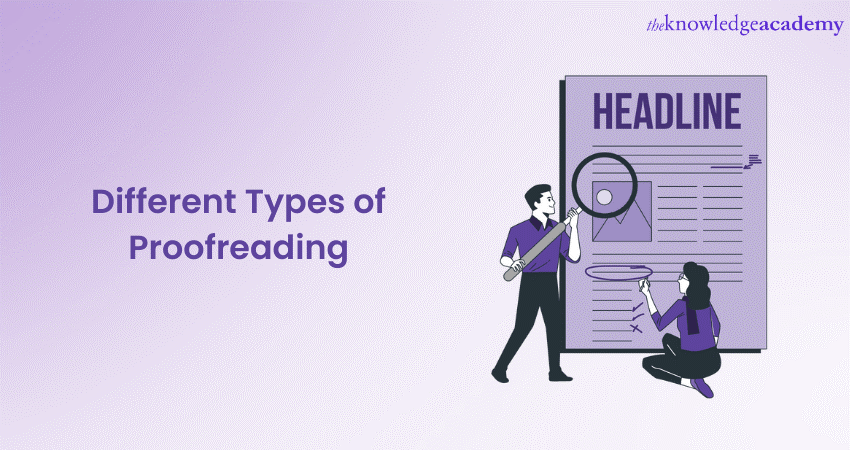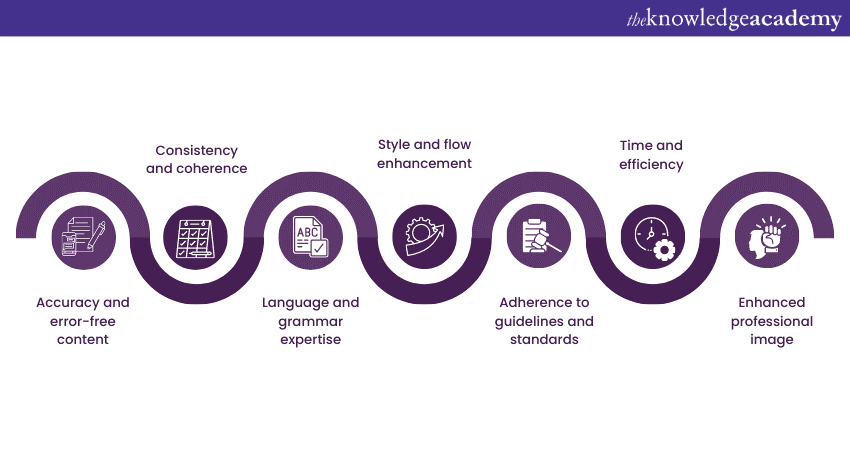We may not have the course you’re looking for. If you enquire or give us a call on +971 8000311193 and speak to our training experts, we may still be able to help with your training requirements.
Training Outcomes Within Your Budget!
We ensure quality, budget-alignment, and timely delivery by our expert instructors.

Proofreading is a critical process that ensures written content is free from errors and presents a professional image to readers. It involves meticulously reviewing and correcting grammar, spelling, punctuation, and formatting mistakes. While many people may think of Proofreading as a straightforward task, it actually encompasses various types, each serving a specific purpose in refining and enhancing written material. Let’s explore the Different Types of Proofreading. Also, understand the nuances and benefits of each type in producing written content.
Table of contents
1) What are the Types of Proofreading?
a) Traditional Proofreading
b) Copy editing
c) Structural Proofreading
d) Technical Proofreading
e) Academic Proofreading
f) Website Proofreading
g) Legal Proofreading
h) Business Proofreading
i) Medical Proofreading
j) The role of a Proofreader
2) Importance of professional Proofreading
3) Conclusion
What are the Types of Proofreading?
Proofreading is crucial to the writing process. It involves carefully reviewing and correcting grammar, spelling, punctuation, and formatting errors. However, not all Proofreading tasks are the same. There are Different Types of Proofreading, each serving a specific purpose in improving the quality of written material. Let’s explore these different types in more detail:
1. Traditional Proofreading
Traditional Proofreading focuses on correcting grammatical, spelling, and punctuation errors. It ensures that the text adheres to grammar rules and maintains consistency throughout. Proofreaders carefully review each sentence and paragraph to identify and correct any errors that may affect the overall readability and understanding of the content.
2. Copy editing
Copy editing goes beyond traditional Proofreading by not only correcting errors but also improving the overall clarity, flow, and readability of the text. Copy editors review the content for sentence structure, word choice, tone, and coherence. They ensure that the writing is engaging and effectively communicates the intended message. Additionally, copy editors may suggest revisions to enhance the style and voice of the writing, making it more compelling and impactful.
3. Structural Proofreading
Structural Proofreading involves assessing the organisation, structure, and coherence of a document. Proofreaders analyse the overall flow of ideas, paragraph structure, headings, and subheadings. They make sure that the content is logically presented and easy to navigate. This type of Proofreading is particularly important for longer documents, such as reports or manuscripts, where the structure is crucial in conveying information effectively.
4. Technical Proofreading
Technical Proofreading is specific to technical documents, such as user manuals, scientific papers, and engineering reports. Proofreaders with expertise in the respective field review the content for accuracy, consistency, and adherence to technical terminology. They ensure that complex concepts are explained clearly and precisely, avoiding any potential confusion or misunderstanding. Technical Proofreading requires a deep understanding of the subject matter and attention to detail to ensure integrity of the information presented and accuracy.

5. Academic Proofreading
Academic Proofreading focuses on checking academic papers, essays, and research articles for accuracy, clarity, and adherence to academic conventions. Proofreaders ensure that citations, references, and formatting styles are correctly applied according to the guidelines, such as APA, MLA, or Harvard. They also look for logical coherence and consistency in arguments, helping to strengthen the academic integrity of the work.
6. Website Proofreading
Website Proofreading aims to enhance the quality of website content to attract and engage visitors. Proofreaders review web pages for spelling and grammatical errors, as well as broken links, formatting issues, and SEO optimisation. They ensure the website provides a seamless user experience and effectively presents information. Website Proofreading also involves checking the consistency of language and tone throughout the site, aligning it with the brand identity and target audience.
7. Legal Proofreading
Legal Proofreading involves reviewing legal documents, contracts, and agreements for accuracy, legal terminology, and proper formatting. Proofreaders familiar with legal language and conventions ensure that the content is error-free and legally sound. They pay close attention to detail, verifying names, dates, and references to ensure their accuracy. Legal Proofreading plays a crucial role in maintaining the integrity and validity of legal documents.
8. Business Proofreading
Business Proofreading focuses on documents related to business communication, such as proposals, presentations, and marketing materials. Proofreaders ensure that the content aligns with the company’s brand voice, is error-free, and effectively conveys the intended message. They may also suggest improvements for clarity and persuasive impact, ensuring that the business documents make a positive and professional impression on the target audience.
9. Medical Proofreading
Medical Proofreading is specific to medical documents, including research papers, clinical reports, and patient information leaflets. Proofreaders with a medical background ensure that the content is accurate, consistent, and adheres to medical terminology. They review the document for any inaccuracies or ambiguities that may affect patient safety or the credibility of the medical information presented. Medical Proofreading plays a crucial role in ensuring the reliability and clarity of medical documents.
These are just some of the different Types of Proofreading that exist. Each type has its own specific focus and requirements, catering to different industries and purposes. By understanding these different types, writers and editors can choose the appropriate approach to ensure their written content is error-free, polished, and effectively conveys their intended message.
To know more about how Proofreading has evolved over the years, refer to our blog on "History of Proofreading"
The role of a Proofreader
The Role of a Proofreader goes beyond the simple task of error correction. They are essential in the writing process as they bring a meticulous and thorough approach to ensuring the accuracy, clarity, and professionalism of written content. Proofreaders have a keen eye for detail, carefully examining every aspect of the text, from grammar and spelling to punctuation and formatting.
One of the key responsibilities of a proofreader is to correct errors that the writer may have overlooked. They not only fix typographical mistakes but also delve deeper into the structure of the sentences and paragraphs. They ensure that the content flows smoothly and coherently, making necessary revisions to enhance readability and understanding.
Proofreaders also play a crucial role in maintaining consistency throughout the document. They pay attention to the use of language, tone, and style, ensuring that it remains uniform and cohesive. By adhering to the specified style guide or brand guidelines, Proofreaders help establish a strong and consistent voice for the written material.
Beyond the technical aspects, Proofreaders also contribute to the overall quality and effectiveness of the content. They carefully assess the logical flow of ideas, making sure that arguments are well-supported and coherent. They may suggest improvements to sentence structures, word choices, and overall clarity, enhancing the impact of the writing.
Their expertise extends to recognising potential issues or ambiguities in the content and addressing them appropriately. Whether it's identifying inconsistencies in facts or ensuring the accuracy of references and citations, Proofreaders ensure that the information presented is reliable and trustworthy.
Discover the transformative power of personal development with our Personal Development Training.
Importance of professional Proofreading
Professional Proofreading ensures that written content is accurate, polished, and error-free. While it may be tempting to rely solely on spell-checkers or self-Proofreading, there are distinct advantages to engaging the services of a professional proofreader. Let’s explore the Importance of Professional Proofreading in more detail:

Accuracy and error-free content
Professional Proofreaders have a keen eye for detail and an in-depth understanding of grammar, spelling, punctuation, and formatting rules. They meticulously review written material, catching even the smallest errors that may be overlooked by the writer. By eliminating errors, professional Proofreading enhances the accuracy and credibility of the content, ensuring it reflects the highest standard of professionalism.
Consistency and coherence
Inconsistent language, style, or formatting can hinder the readability and impact of written content. Professional Proofreaders pay attention to consistency in language, tone, and formatting throughout the document, ensuring a coherent and seamless reading experience. They align the content with the specified style guide or brand guidelines, maintaining a consistent voice that strengthens the overall message.
Language and grammar expertise
Professional Proofreaders deeply understand the English language, including its grammar rules, nuances, and conventions. They are skilled in identifying and rectifying grammatical errors, awkward sentence structures, and improper word usage. By applying their language expertise, professional Proofreaders enhance the clarity and precision of the writing, making it more accessible to the intended audience.
Embark on a journey of self-expression and storytelling excellence with our Creative Writing Training.
Style and flow enhancement
A professional proofreader not only corrects errors but also improves the overall style, flow, and readability of the content. They identify opportunities to enhance sentence structures, eliminate redundant phrases, and suggest alternative word choices to enhance the overall impact. Their keen editorial eye helps refine the writing, ensuring it engages and captivates the reader from start to finish.
Adherence to guidelines and standards
Different industries and contexts often have specific guidelines, style manuals, or formatting requirements. Professional Proofreaders are well-versed in these guidelines and ensure that the content adheres to them. Whether it is academic formatting styles, legal terminology, or industry-specific jargon, professional Proofreaders ensure that the content meets the necessary standards, adding a layer of professionalism and expertise to the final product.
Time and efficiency
Writing can be time-consuming, and self-Proofreading can be daunting, especially for lengthy or complex documents. Professional Proofreaders bring efficiency to the process by taking on the responsibility of reviewing and correcting errors. By entrusting the Proofreading task to professionals, writers can focus on other aspects of their work and save time, knowing that their content is in expert hands.
Enhanced professional image
Error-free, polished content reflects positively on the writer or organisation. It instils trust, credibility, and professionalism in the eyes of the audience. By employing professional Proofreading services, individuals and businesses can ensure that their written materials, whether it's business communications, marketing collateral, academic papers, or legal documents, project a strong professional image.
To leverage your review process, refer our blog on "Proofreading tips"
Conclusion
Understanding the various Types of Proofreading is crucial in ensuring the quality and accuracy of written content. From traditional Proofreading to specialised forms such as technical, academic, or legal Proofreading, each type serves a specific purpose in refining and perfecting written material. These diverse types provide valuable tools to achieve professional and impactful written communication.
Unlock your potential as a wordsmith by joining our Proofreading Masterclass.
Frequently Asked Questions
Upcoming Business Skills Resources Batches & Dates
Date
 Proofreading Course
Proofreading Course
Fri 14th Feb 2025
Fri 11th Apr 2025
Fri 13th Jun 2025
Fri 15th Aug 2025
Fri 10th Oct 2025
Fri 12th Dec 2025







 Top Rated Course
Top Rated Course


 If you wish to make any changes to your course, please
If you wish to make any changes to your course, please


